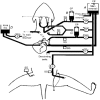Absence of early resetting of coronary baroreceptors in anaesthetized dogs
- PMID: 9807002
- PMCID: PMC2231288
- DOI: 10.1111/j.1469-7793.1998.543bb.x
Absence of early resetting of coronary baroreceptors in anaesthetized dogs
Abstract
1. Both carotid and aortic arch baroreceptors have been shown to reset after as little as 20 min exposure to a different conditioning pressure; the mid-point of the stimulus-response curve is displaced towards the conditioning pressure. 2. Coronary baroreceptors operate over much lower pressures and induce slower reflex vasoconstriction than the other baroreceptors and this investigation was designed to determine whether their resetting characteristics are also different. 3. In chloralose anaesthetized dogs, a perfusion circuit allowed independent control of pressures distending carotid, aortic and coronary baroreceptors. Stimulus-response curves were obtained for carotid and coronary baroreceptors after maintaining the distending pressure at 60 or 180 mmHg for 20 min. 4. Neither the magnitude of the responses nor the baroreceptor pressure corresponding to 50 % of the response (BP50) of the coronary curves was changed by the conditioning regime. In contrast, conditioning carotid baroreceptors with the same regime produced significant shifts in the BP50 towards the conditioning pressure. 5. No changes were obtained after conditioning the coronary baroreceptors at 60 or 120 mmHg for 40 min. 6. These results confirm early resetting of carotid baroreceptors but show that coronary baroreceptors do not reset over a period of at least 40 min.
Figures


 ) and 180 mmHg (
) and 180 mmHg ( ) for 20 min (n= 6).
) for 20 min (n= 6).
 ) and 180 mmHg (
) and 180 mmHg ( ) for 20 min (n= 6).
) for 20 min (n= 6).
 ) and 120 mmHg (
) and 120 mmHg ( ) for 40 min (n= 6).
) for 40 min (n= 6).Similar articles
-
Vascular responses to stimulation of carotid, aortic and coronary artery baroreceptors with pulsatile and non-pulsatile pressures in anaesthetized dogs.Exp Physiol. 1996 Nov;81(6):969-81. doi: 10.1113/expphysiol.1996.sp003997. Exp Physiol. 1996. PMID: 8960703
-
Reflex vascular responses from aortic arch, carotid sinus and coronary baroreceptors in the anaesthetized dog.Exp Physiol. 1996 May;81(3):397-408. doi: 10.1113/expphysiol.1996.sp003944. Exp Physiol. 1996. PMID: 8737074
-
Phasic negative intrathoracic pressures enhance the vascular responses to stimulation of pulmonary arterial baroreceptors in closed-chest anaesthetized dogs.J Physiol. 2004 Mar 16;555(Pt 3):815-24. doi: 10.1113/jphysiol.2003.057968. Epub 2004 Jan 14. J Physiol. 2004. PMID: 14724182 Free PMC article.
-
Role of baroreceptor resetting in cardiovascular regulation: acute resetting.Fed Proc. 1985 May;44(8):2408-11. Fed Proc. 1985. PMID: 3886429 Review.
-
Mechanisms of resetting of arterial baroreceptors: an overview.Am J Med Sci. 1988 Apr;295(4):327-34. doi: 10.1097/00000441-198804000-00019. Am J Med Sci. 1988. PMID: 2834951 Review.
Cited by
-
Differential contributions of cardiac, coronary and pulmonary artery vagal mechanoreceptors to reflex control of the circulation.J Physiol. 2022 Sep;600(18):4069-4087. doi: 10.1113/JP282305. Epub 2022 Aug 29. J Physiol. 2022. PMID: 35903901 Free PMC article. Review.
-
The coronary baroreflex in humans.J Extra Corpor Technol. 2005 Sep;37(3):306-10. J Extra Corpor Technol. 2005. PMID: 16350386 Free PMC article. Clinical Trial.
-
Cardiovascular regulation in the period preceding vasovagal syncope in conscious humans.J Physiol. 2003 May 15;549(Pt 1):299-311. doi: 10.1113/jphysiol.2002.036715. Epub 2003 Apr 4. J Physiol. 2003. PMID: 12679368 Free PMC article.
References
-
- Abráhám A. Die nervenversorgung der kranzgefässe des herzens. Archives Internationales de Pharmacodynamie et de Thérapie. 1962;139:17–27. - PubMed
-
- Andresen MC, Yang M. Dynamic and static conditioning pressures evoke equivalent rapid resetting in rat aortic baroreceptors. Circulation Research. 1990;67:303–311. - PubMed
-
- Brunner MJ, Kligman MD. Rapid resetting of baroreflexes in hypertensive dogs. American Journal of Physiology. 1992;262:H1508–1514. - PubMed
-
- Chen HI, Chang K-C, Liu H-C, Lin C-H. Acute adaptation and resetting of the baroreflex control of vascular resistance in the canine hindquarters and mesentery. Pflügers Archiv. 1993;424:276–284. - PubMed
Publication types
MeSH terms
LinkOut - more resources
Full Text Sources
Research Materials

